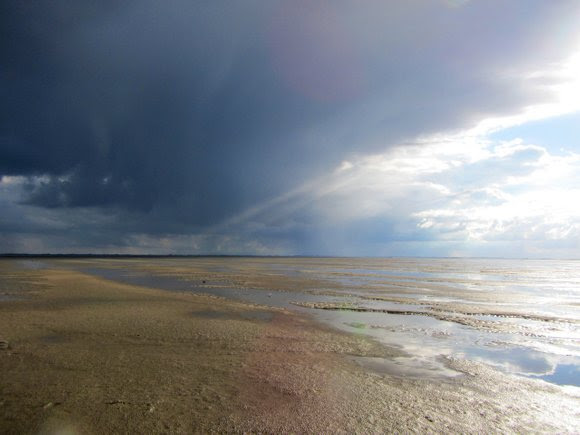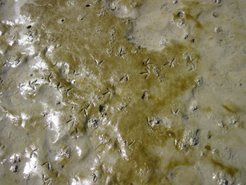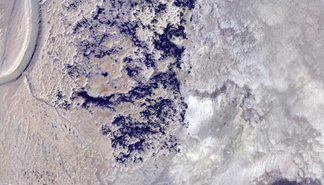Mudflats are the solar panels of the Wadden Sea
The miniscule diatoms on the mudflats of the Wadden Sea are the main source of energy for the rest of the food web there. This surprising finding will be published in scientific journal Ecology this month by Marjolijn Christianen, a postdoc at the Groningen Institute for Evolutionary Life Sciences (GELIFES) of the University of Groningen and colleagues from the Royal Netherlands Institute for Sea Research (NIOZ) and Utrecht University.
In the recently completed Waddensleutels programme, researchers and conservationists from NIOZ, the University of Groningen and conservation organizations Natuurmonumenten and Staatsbosbeheer worked together on one of the largest ecology research projects in the Netherlands. The aim was to determine the composition and structure of the food web in the Dutch Wadden Sea.
Solar panels
The study by Christianen and researchers from other institutes showed that the miniscule diatoms (also known as benthic diatoms or microphytobenthos) that live on the mudflats of the Wadden Sea are the main source of energy for life there. They form the basis of the food web, and are eaten by the majority of animals higher in the food chain, including worms, molluscs, crustaceans, fish and birds. The diatoms capture the sun’s energy, which means that the mudflats where they live can be seen as the solar panels of the Wadden Sea.
Self-sufficient
This shows that the Wadden Sea is self-sufficient. In contrast to previous assumptions, most of the energy in the food web is produced in rather than outside the Wadden Sea, and thus not by floating plankton from the North Sea or rivers. The researchers reached this conclusion by measuring stable carbon isotopes in the tissue of 178 plant and animal species that they collected in the Dutch Wadden Sea. They collected about 12,000 plant and animal samples from across the Wadden Sea, ranging from the blood of the Eurasian spoonbill to the muscle of crabs in order to document the entire food web. This enabled them to determine the organisms’ primary sources of carbon and their spatial variability.
Management of coastal ecosystems
The findings have important implications not only for our understanding of how ecosystems work but also for the management of coastal ecosystems in general and of the world’s largest intertidal ecosystem, the Wadden Sea, in particular. They show how important it is to protect the tidal flats that provide a home to the diatoms, to ensure that these ‘solar panels’ continue to provide energy.
More information
- This research was the collaboration of Natuurmonumenten, Staatsbosbeheer, the University of Groningen, NIOZ and the University of Utrecht within the Waddensleutels programme. The Waddensleutels research was funded by the Waddenfonds.
- Contact: Marjolijn Christianen , Groningen Institute for Evolutionary Life Sciences (GELIFES) of the University of Groningen.
- Benthic primary producers are key to sustain the Wadden Sea food web: stable carbon isotope analysis at landscape scale. Christianen, M.J.A., Middelburg, J.J., Holthuijsen, S.J., Jouta, J., Compton, T.J., van der Heide, T., Piersma, T., Sinninghe Damsté, J.S., van der Veer, H.W., Schouten, S. and Olff, H. (2017), Ecology. http://onlinelibrary.wiley.com/doi/10.1002/ecy.1837/full



| Last modified: | 07 September 2020 4.34 p.m. |
More news
-
23 April 2024
Nine MSCA Doctoral Network grants for FSE researchers
Nine researchers of the Faculty of Science and Engineering have received a Horizon Europe Marie Sklodowska Curie Doctoral Network grant.
-
22 April 2024
Charissa Roossien secures JTF subsidy to develop Health Tracker
Dr. Charissa Roossien (ENTEG) has successfully secured a Just Transition Fund (JTF) subsidy of 1.8 million euros to develop a Health Tracker for reliable respiratory and metabolic analysis.
-
15 April 2024
Night vision with artificial atoms
Every two weeks, UG Makers puts the spotlight on a researcher who has created something tangible, ranging from homemade measuring equipment for academic research to small or larger products that can change our daily lives. That is how UG...
